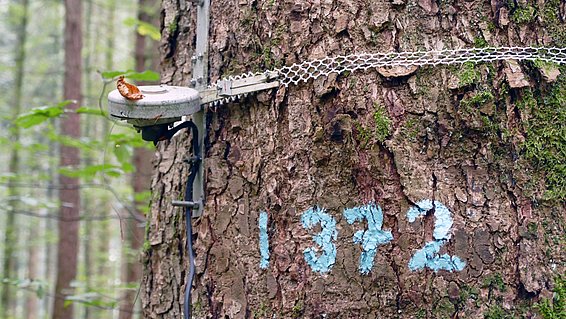16.07.2024 | Beate Kittl | WSL News
The European Commission is planning to monitor forests more closely, combining data from the ground and from the air. However, its proposal ignores important existing resources, criticise forest researchers from all over Europe in an opinion piece in "Forest Ecology and Management".
Climate change will have a massive impact on forests. This jeopardizes important ecosystem services they provide, for example as carbon sinks by removin CO2 from the atmosphere. It is therefore important to keep a close eye on the forests. But a new proposal from the European Commission on forest monitoring threatens to be a missed opportunity, write 20 forest researchers from several European countries in an opinion piece. Two WSL researchers explain their reasons and counterproposals.
Arthur Gessler is forest ecologist at WSL and head of the SwissForestLab
Marco Ferretti is forest ecologist, head of the WSL Forest Resources and Management Research Unit and Chairman of the ICP Forests

Because climate change will impact and change Europe's forests, the European Commission is launching a new coordinated forest monitoring programme. It will combine data collected on the ground with satellite data. What's wrong with that?
Arthur Gessler: It's great that the Commission and the European Parliament are thinking about the new challenges facing forest monitoring. However, what puzzled us about the proposal is that it ignores many existing forest monitoring systems. It omits important resources that already exist in terms of forest health.
What does the Commission's proposal envisage?
Gessler: It aims to coordinate and harmonize the national forest inventories of the EU member states more closely. Their data should then be linked with those obtained by satellite remote sensing. The European Union operates Copernicus, an earth observation system that records very detailed forest images in terms of space and time for the whole of Europe and beyond. That in itself is excellent.
What do you criticise then?
Gessler: That the proposal focusses exclusively on the national forest inventories, like the one we have in Switzerland (LFI). Although they have a dense network of plots, each plot is only surveyed every several years or so. Forest health aspects such as crown thinning are not even recorded in the inventories. And the European Commission wants these to be explicitly taken into account. We already have various existing monitoring approaches that work with standardised methods and monitor the health of forests as well as many processes that are linked to ecosystem services.
Which ones, for example?
Gessler: In Switzerland, for example, on long-term forest ecosystem research (LWF). This is our health check for the forest. The LWF, in turn, is part of the Europe-wide monitoring programme ICP Forests, which collects data on the condition of forests everywhere using the same methods and at the same time intervals. Another programme is the ICOS carbon observatory, which measures the fluxes of carbon between ecosystems and the atmosphere.
And the Commission has forgotten about these initiatives?
Gessler: That seems to be the case. It is interesting to note that ICP Forests and other institutions received start-up funding from the European Union for a very long time. In cooperation with the United Nations, they were established in the 1980s as part of the forest dieback debate.
Who came up with this new proposal?
Marco Ferretti: It comes from the European Commission's Directorate-General for the Environment Link and is based on the EU Forest Strategy 2030. It was developed through a public consultation process, experts and scientific workshops. Why it ignores the other monitoring systems is not explained - and there is no clear reason why.
What do you suggest such EU-wide monitoring should look like?
Gessler: It makes sense and is important to compare remote sensing data of the forest with ground-based approaches, as is now being proposed. There are already research activities in this area. If we bring together the different existing networks, including the national inventories, they will complement each other perfectly. It won't even be more expensive because we can draw on existing experience and data.
Are you alone in your criticism?
Ferretti: Obviously not, as the large and international co-authorship of the opinion paper clearly demonstrates. Also the European State Forestry Association (EUSTAFOR), which is committed to sustainable forest management and timber production, has also criticised the proposal.
Forest monitoring in Switzerland and Europe
The Swiss Federal Institute for Forest Research WSL's Long-term Forest Ecosystem Research programme (LWF) investigates how air pollution and climate change affect forests. The LWF programme generates around 25 million measurements every year. The data series date back to 1994 (LWF corresponds to the ICP Forests Level II areas) and 1985 (Sanasilva inventory, corresponds to Level I).
With the statutory tasks of the LWF programme, Switzerland participates in international research and monitoring programmes such as ICP Forests or the LTER Europe network (Long-Term Ecosystem Research in Europe).
The WSL also carries out the Swiss National Forest Inventory (NFI). The NFI is mainly based on a systematic sample inventory and provides data and findings on forest area, stock, increment, felling, biodiversity, protective forest quality and socio-cultural services of forests. The information is also incorporated into international climate and forest reporting (e.g. greenhouse gas inventory, State of Europe's Forests, Forest Resource Assessment of the FAO).
As part of the SwissAIM initiative, WSL is developing concepts for closer cooperation between LFI and LWF.
Contact ¶
Publication ¶
Ferretti M., Gessler A., Cools N., Fleck S., Guerrieri R., Jakovljević T., … Sanders T.G.M. (2024) Resilient forests need joint forces for better inventorying and monitoring. For. Ecol. Manag. 561, 121875 (6 pp.). https://doi.org/10.1016/j.foreco.2024.121875Institutional Repository DORA
Always up to date: Subscribe to the WSL Newsletter.
Copyright ¶
WSL and SLF provide image and sound material free of charge for use in the context of press contributions in connection with this media release. The transfer of this material to image, sound and/or video databases and the sale of the material by third parties are not permitted.


